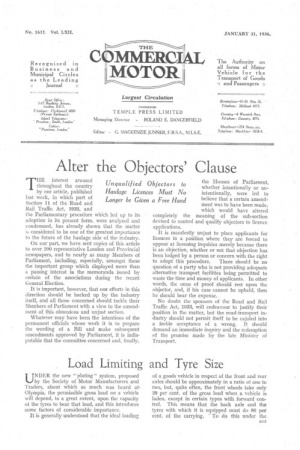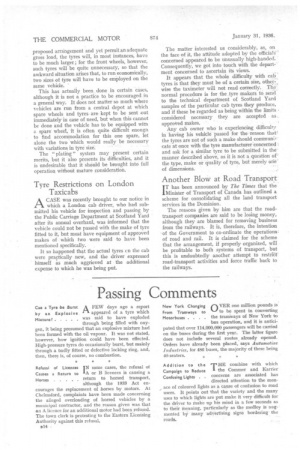Load Limiting and Tyre Size UU NDER the new " plating
Page 23

Page 24

If you've noticed an error in this article please click here to report it so we can fix it.
" system, proposed by the Society of Motor Manufacturers and Traders, about which so much was heard at, Olympia, the permissible gross load on a vehicle will depend, to a great extent, upon the capacity of the tyres to bear that load, and this introduces some factors of considerable importance.
It is generally understood that the ideal loading of a goods vehicle in respect of the front and rear axles should be approximately in a ratio of one to two, but, quite often, the front wheels take only 20 per cent, of the gross load when a vehicle is laden, except in certain types with forward control. This means that the back axle and the tyres with which it is equipped must do 80 per cent. of the carrying. ' To do this under the proposed arrangement and yet permit an adequate gross load, the tyres will, in most instances, have to be much larger; for the front wheels, however, such tyres will be quite unnecessary, so that the awkward situation arises that, to run economically, two sizes of tyre will have to be employed on the same vehicle.
This has actually been done in certain cases, although it is not a practice to be encouraged in a general way. It does not matter so much where vehicles are run from a central depot at which spare wheels and tyres, are kept to be sent out immediately in case of need, but when this cannot be done and the vehicle has to be equipped with a spare wheel, it is often quite difficult enouga to find accommodation for this one spare, let alone the two which would really be necessary with variations in tyre size.
The " plating" system may present certain• merits, but it also presents its difficulties, and it is undesirable that it should be brought into full operation without mature consideration.
Tyre Restrictions on London Taxicabs
ACASE was recently brought to our notice in which a London cab driver, who had subnutted his vehicle for inspection and passing by the Public Carriage Department at Scotland Yard after its annual overhaul, was informed that the vehicle could not be passed with the make of tyre fitted to it, but must have equipment of approved makes of which two were said to have been mentioned specifically.
It so happened that the actual tyres co the cab were practically new, and the driver expressed himself as much aggrieved at the additional expense to which he was being put. The matter interested us considerably, as, on the face of it, the attitude adopted by the officials concerned appeared to be unusually high-handed. Consequently, we got into touch with the depart ment concerned to ascertain its views.
It appears that the whole difficulty with cab tyres is that they must be of a certain size, othervise the taximeter will not read correctly. The-. normal procedure is for the tyre makers to. send to the technical department of Scotland Yard samples of the particular cab tyres they produce, and if these be regarded as being within the limits considered necessary they are accepted as,. approved makes. Any cab owner who is experiencing difficulty in having his vehicle passed for the reason that the tyres are not of such a make should communiJ cate at once with the tyre manufacturer concerned and ask for a similar tyre to be submitted in the manner described above, as it is not a question of . the type, make or quality of tyre, but merely one of dimensions.
Another Blow at Road Transport
I T has been announced by The Times that the Minister of Transport of Canada has outlined a scheme for consolidating all the land transport services in the Dominion.
The reasons given by him are that the roadtransport companies are said to be losing money, although they are blamed for removing business from the railways. It is, therefore, the intention of the Government to co-ordinate the operations of road and rail. It is claimed for the scheme that the arrangement, if properly organized, will be profitable to both systems of transport, but this is undoubtedly another attempt to restrra road-transport activities and force traffic back to the railways.




















































































